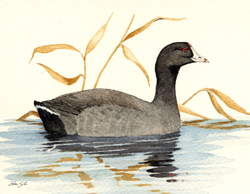Breeding Bird Atlases (BBA)
Find a Bird - BBA1
Breeding Bird Atlas 1 Species Accounts
American Coot
Fulica americana
Egg Dates
early May to early August
Number of Broods
one; may re-lay if first attempt fails.

The American Coot, or Mudhen, is a common breeding species in many freshwater areas, especially in the western United States and Canada. It is also well distributed in the Southeast but is uncommon and local throughout the northeastern United States and eastern Canada. In Massachusetts, there is one old possible breeding record from the western part of the state in Cheshire. In the latter part of the 1960s, American Coots began to breed at Plum Island and at the Great Meadows National Wildlife Refuge in Concord. This represented a range expansion that also occurred during the same period in New York.
During the Atlas project, they were present but not confirmed breeding in Concord, and the small population, at most several pairs, did not increase at Plum Island. Both of these sites are human-made freshwater impounded areas. Perhaps subtle changes in the habitat at these locations prevented the expansion of the population. Breeding is erratic, with nesting attempts not undertaken every year.
The coot is a very uncommon spring migrant, usually arriving in early April. By the middle of May, the few migrants have departed, and only breeding individuals remain. The preferred nesting site is an open body of water with marshlike edges (e.g., cattails and associated plants) rather than the denser marsh areas prefered by its close relative, the Common Moorhen. The voice is a series of grunting kuk notes and other clucking noises, again similar to those of the moorhen but sufficiently different to establish the identity of the caller by persons familiar with both species.
The nest is constructed from dried leaves and stems of marsh plants and may be located in the open or concealed in the marsh, sometimes on a natural platform or simply secured to live vegetation. A large clutch of eggs numbering up to a dozen is laid during May. The incubation period lasts about three weeks. The downy chicks are characteristically black in color, with rust on the head and neck, and the bill is red with a black tip. During the early stages of development, the young parade behind the parent. Both sexes share in incubation and care of the young. Juveniles can fly 49 to 56 days after hatching. Four Massachusetts brood dates range from June 2 to August 11. Brood size ranged from one to eight (BOEM, Petersen). It appears that late broods result from re-nesting after the initial attempt has failed.
Little is known about postbreeding events. An immature bird, too young to be a migrant, was observed on September 18 (Petersen). In the fall, American Coots are common and at times abundant migrants. They congregate on ponds and lakes, generally avoiding the marshlike habitat preferred for breeding. Numbers are greatest in late October and November. At times, impressive rafts numbering in the hundreds have been encountered, but there seems to have been a decline in the past decade, with small groups of fewer than 50 individuals being the norm.
The bulk of the migrants move farther south as winter approaches, joining the tremendous rafts of this species that occur from the mid-Atlantic states south to Florida. A small wintering population remains scattered along the coast, especially on Cape Cod and the Islands.
Map Legend and Data Summary
Atlas 1 data collected from 1975-1979


Note: rare and irregular at Parker River National Wildlife Refuge; occasionally elsewhere
Richard A. Forster



